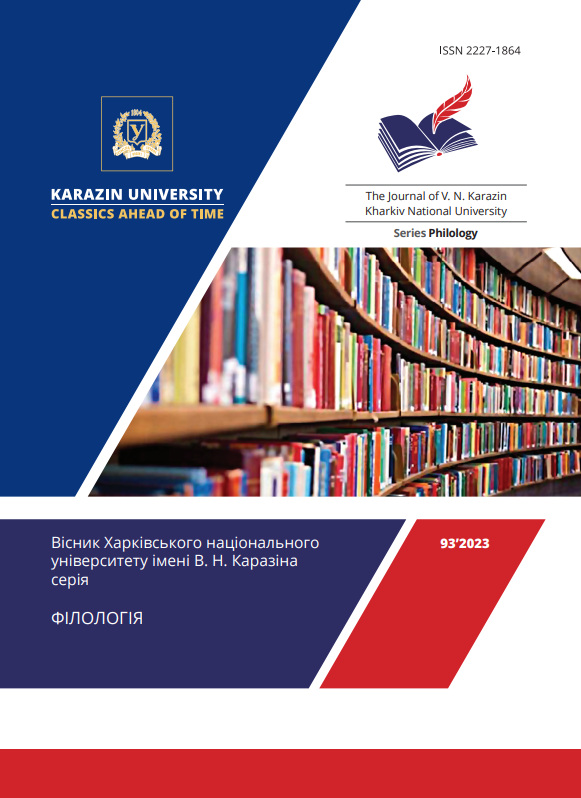Phraseological units with a numerical component hundred in Ukrainian and Chinese
Abstract
Intermedial The article is devoted to a comparative analysis of Ukrainian and Chinese phraseological units with the numerical component hundred as a component of the concept “all”. A holistic and exhaustive linguoculturological study of the concept “all”on the basis of phraseological units of the Chinese and Ukrainian languages has not been carried out, that determines the relevance of the article. The purpose of the article is to clarify and detail some aspects of the language representation of the concept “all” on the material of two languages. The paper describes the role of numbers in traditional Chinese culture; certain structural and cultural features of phraseological units in the Chinese language are determined; identified, classified, analyzed and compared phraseological units with the component “hundred” in the Ukrainian and Chinese languages.
The results of the study provide grounds for clarifying the content of the concept “all”. The numerative hundred is a productive component of Chinese phraseological units, in which it can be a temporal indicator, the embodiment of the idea of diversity. Structural features of Chinese phraseological units: PU with different semantics and connotative colouring have the same negative structure; within one unit, the numeratives 1–100 are contrasted, the numeral hundred is doubled, the numeratives hundred and thousand are used. The equivalents of Ukrainian phraseological units with the numerical component one hundred were found in Chinese. In Ukrainian and Chinese cultures some emotional and evaluative components are similar: negative (submission, sadness, indifference to life), positive (invincibility, value of a specialist). In Chinese most phraseological units with a numerical component hundred are used to characterize a certain state of a person, particular phenomena. The study of phraseological units in Ukrainian and Chinese will deepen the content of the concept “all” in the language picture of the world. The research results can be used in the process of compiling phraseological Ukrainian-Chinese dictionaries and in the practice of studying both languages.
Downloads
References
Akulenko, V. V. (1990). About the expression of quantity in the semantics of the language. In The category of quantity in modern European languages (pp.7–40). Kyiv: Nauk. Dumka.
Akulenko, V. V. (1998). Ukrainian language in the European context: the problem of development of language communication. Linguistics. 1998, 2/3, 91–97.
Baudouin de Courtenay, I. A. (1963). Quantitativeness in language thinking. In I. A. Baudouin de Courtenay. Works on general linguistics: in 2 volumes (pp. 311–324). Moscow: Izdatielstvo Akademii nauk USSR.
Vezhbytskaya, A. (1996). Language. Culture. Cognition. Moscow: Russkye slovary.
Golubovskaya, I. O. (2004). Ethnic features of language pictures of the world. Monograph. Kyiv: Logos.
Gotlib, O. M., & Mu, Huaiin. (2019). Chinese-Russian Phraseological Dictionary. Irkutsk: IGU Publishing House.
Granet, M. (2016). Chinese civilization. Moscow: Algorithm.
Kobzev, A. I. Teaching about symbols and numbers in Chinese classical philosophy. Retrieved from https://www.phantastike.com/philosophy/doctrine_symbols_numbers/djvu/view/.
Lisichenko, L. A. (2009). Lexico-semantic dimension of the language picture of the world. Monograph. Kharkiv: VH «Osnova».
Radchuk, O. V. (2019). Linguo-cognitive representation of the concept «absence» in the Russian language. Monograph. Kharkiv: Yurayt.
Skorobogatova, E. A. (2021). Grammatical representation of the concept completeness in Russian poetic discourse: cognitive basis and functioning. Naukovi zapysky. G. S. Skovoroda KhNPU. The series «Literature Studies». 2 (98), 168–192.
Sukalenko, N. I. (1992). Reflection of everyday consciousness in the figurative language picture of the world. Kyiv: Nauk. Dumka.
Wu, Guohua. (1996). Cultural lexicology. Harbin: Heilujian People`s Press.
Phraseological dictionary of Ukrainian language. Retrieved from https://slovnyk.me/dict/phraseology/%D1%81%D1%82%D0%BE
Fibonacci number. Why is it so popular in nature? Retrieved from https://hi-news.ru/science/chislo-fibonachchi-pochemu-ono-tak-populyarno-v-prirode.html?ysclid=lg83wtsrhn9178122
Jacobson, R. (1985). Selected Works. Moscow: Progress.
Gao, Yongxin. (2021). Research of Chinese Idioms. Changchun: Jilin Publishing Group.
Liu, Hongyan. (2022). Study of the Meaning of Chinese Idioms. Beijing: People’s Press.




